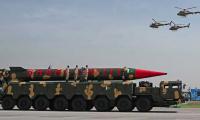Air quality is improving in countries under coronavirus quarantines, experts say, but it is far too early to speak of long-term change.
Images by the US space agency Nasa are clear, in February the concentration of nitrogen dioxide (NO2) fell dramatically in Wuhan, China, the epicentre of the COVID-19 pandemic, passing from an indicator that was red/orange to blue.
NO2 is mainly produced by vehicles, industrial sites and thermal power stations. As China moves past the peak of its crisis, however, recent images by the European Space Agency (ESA) show a resurgence in NO2 emissions.
A striking reduction has also been observed by the ESA in northern Italy, which has been locked down to fight a spread of the novel coronavirus, which causes COVID-19. The European Environment Agency (EEA) reports a similar change in Barcelona and Madrid, where Spanish authorities issued confinement orders in mid March.
"NO2 is a short-lived pollutant, with a lifetime in the atmosphere of about one day," said Vincent-Henri Peuch, from the EU earth surveillance programme Copernicus. "As a result, this pollutant stays near the emissions sources and can be used as a proxy of the intensity of activity in different sectors," he told AFP.
Fei Liu, an air quality researcher at Nasa’s Goddard Space Flight Center, noted the change in China, saying: "This is the first time I have seen such a dramatic drop-off over such a wide area for a specific event."
Even during the economic crisis more than a decade ago, the decrease in NO2 levels "was more continuous in time," according to EEA air quality specialist Alberto Gonzalez Ortiz. In northern Italy, "average NO2 concentration levels have been almost halved on average," Peuch remarked.
The pollutant can provoke serious inflammation of the respiratory system. As for other countries or regions that have told inhabitants to remain confined at home, notably Argentina, Bavaria, Belgium, California, France and Tunisia, specialists are poring over the data to see if the trend is similar.
Meanwhile, less NO2 does not necessarily mean purer air. Beijing experienced episodes of pollution owing to fine particles in February, Nasa’s Earth Observatory reported. The air in Paris was also rated as moderately polluted on Friday owing to the presence of fine particles and NO2 even though the population had already been confined at home for three days.
Peuch explained that the concentration of polluting matter can vary with the weather. "Some emissions sources, like energy production and residential use of energy are likely not to be decreasing markedly when more people have to stay at home," he noted. The concentration of so-called PM2.5 and PM10 particles and carbon monoxide (CO) are "also expected to be reducing over time," Peuch said.
Lieutenant General Igor Kirillov, who was chief of Russia’s Nuclear, Biological and Chemical Protection Troops. —...
US President-elect Donald Trump speaks at an event in West Palm Beach, Florida. — AFP/File WASHINGTON: Donald Trump...
Refugees sleep outside the entrance of the Swedish Migration Agency's arrival centre for asylum seekers at Jagersro in...
UN Special Envoy for Syria Geir Pedersen attends a news conference ahead of the meeting of the Syrian Constitutional...
India's Prime Minister Narendra Modi shows his ink-marked finger after casting his vote during the third phase of the...
Moscow has courted relations with Taliban since they seized power in Afghanistan in 2021







